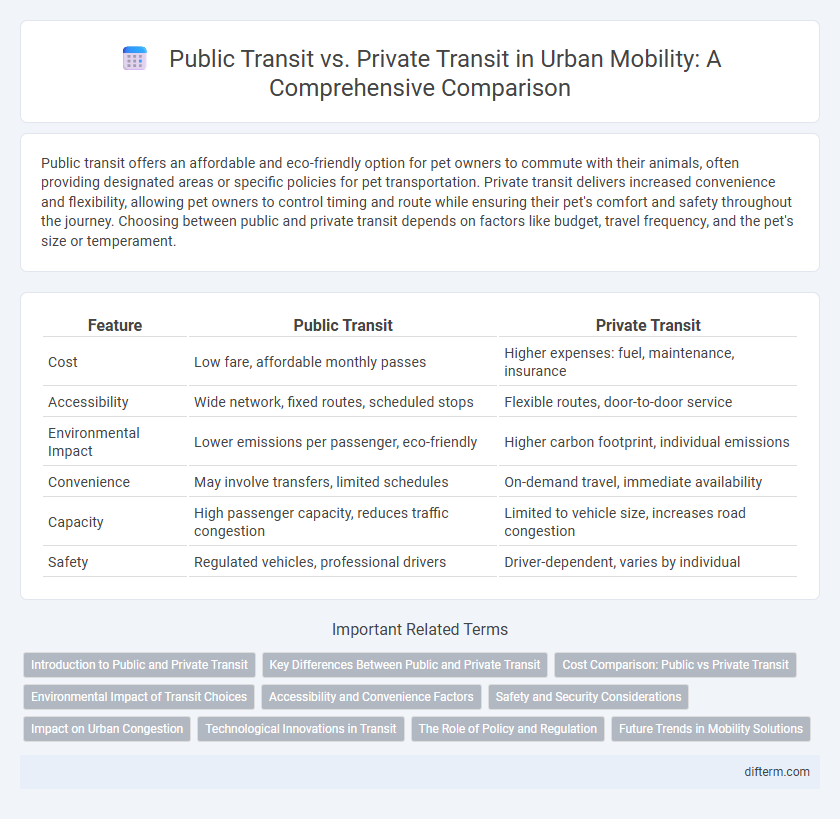Public transit offers an affordable and eco-friendly option for pet owners to commute with their animals, often providing designated areas or specific policies for pet transportation. Private transit delivers increased convenience and flexibility, allowing pet owners to control timing and route while ensuring their pet's comfort and safety throughout the journey. Choosing between public and private transit depends on factors like budget, travel frequency, and the pet's size or temperament.
Table of Comparison
| Feature | Public Transit | Private Transit |
|---|---|---|
| Cost | Low fare, affordable monthly passes | Higher expenses: fuel, maintenance, insurance |
| Accessibility | Wide network, fixed routes, scheduled stops | Flexible routes, door-to-door service |
| Environmental Impact | Lower emissions per passenger, eco-friendly | Higher carbon footprint, individual emissions |
| Convenience | May involve transfers, limited schedules | On-demand travel, immediate availability |
| Capacity | High passenger capacity, reduces traffic congestion | Limited to vehicle size, increases road congestion |
| Safety | Regulated vehicles, professional drivers | Driver-dependent, varies by individual |
Introduction to Public and Private Transit
Public transit systems, including buses, subways, and trams, offer cost-effective and environmentally friendly transportation options by serving multiple passengers along fixed routes and schedules. Private transit, characterized by personal vehicles such as cars and motorcycles, provides flexibility and convenience but often contributes to traffic congestion and higher emissions. Comparing these modes highlights the balance between accessibility, efficiency, and environmental impact in urban mobility planning.
Key Differences Between Public and Private Transit
Public transit operates on fixed routes and schedules, serving large populations with cost-effective, environmentally friendly options like buses and trains. Private transit offers personalized, flexible travel with convenience and comfort, including ride-sharing services and private vehicles. Key differences lie in accessibility, cost structure, environmental impact, and user control over travel time and routes.
Cost Comparison: Public vs Private Transit
Public transit offers significantly lower average costs per trip, with fares typically ranging from $1.50 to $3.00, compared to private transit expenses including fuel, insurance, and maintenance that can exceed $0.50 per mile and total monthly costs upward of $700. Infrastructure investments and subsidies further reduce effective public transit costs, making it a more economical choice for daily commuting versus private vehicle ownership. High private transit costs stem from variable fuel prices, depreciation, and parking fees, highlighting the financial disparity between the two modes of mobility.
Environmental Impact of Transit Choices
Public transit significantly reduces greenhouse gas emissions by decreasing the number of private vehicles on the road, leading to lower overall carbon footprints per passenger mile. Electric buses and trains powered by renewable energy further minimize air pollution and fossil fuel consumption compared to gasoline-powered cars. Shifting to mass transit systems promotes sustainable urban growth and helps cities achieve climate goals by reducing traffic congestion and energy demand.
Accessibility and Convenience Factors
Public transit systems offer greater accessibility by providing multiple routes and stops that connect diverse urban areas, making it easier for individuals without personal vehicles to travel efficiently. Convenience factors such as frequent service schedules, real-time tracking apps, and integrated payment systems enhance user experience and reduce wait times compared to private transit. In contrast, private transit offers door-to-door convenience but often lacks affordability and accessibility for broader populations, limiting mobility options for many users.
Safety and Security Considerations
Public transit systems implement extensive safety measures such as surveillance cameras, emergency communication systems, and regular staff training to ensure passenger security. Private transit options often rely on personal vigilance and vehicle maintenance, which can result in varied safety levels. Statistically, public transit has a lower incidence of accidents and crime per passenger mile compared to private vehicles, highlighting its relative security advantage.
Impact on Urban Congestion
Public transit significantly reduces urban congestion by transporting a large number of passengers in fewer vehicles, decreasing the total number of cars on the road. Private transit, including personal cars and ride-sharing services, often contributes to increased traffic due to higher vehicle occupancy rates and inefficient road space utilization. Cities with extensive public transit networks experience lower congestion levels, improved air quality, and more efficient use of urban infrastructure.
Technological Innovations in Transit
Technological innovations in public transit, such as real-time tracking systems, electric buses, and automated fare collection, significantly enhance efficiency and reduce environmental impact compared to private transit. Advanced mobility platforms integrate multimodal transport options, enabling seamless trip planning and reduced congestion. Private transit vehicles increasingly adopt electric and autonomous technologies, but public transit's scale and network integration offer superior overall sustainability and accessibility benefits.
The Role of Policy and Regulation
Policy and regulation play a critical role in shaping the balance between public and private transit by setting standards for safety, accessibility, and environmental impact. Urban mobility initiatives often prioritize investments in public transit infrastructure to reduce congestion and lower carbon emissions, while regulations govern private transit services such as ride-sharing to ensure fair competition and user protection. Effective policy frameworks promote integration between modes, facilitating seamless and sustainable transportation options for diverse populations.
Future Trends in Mobility Solutions
Emerging mobility solutions emphasize the integration of public transit systems with shared electric vehicles and autonomous shuttles to reduce urban congestion and lower carbon emissions. Smart infrastructure and real-time data analytics enhance route efficiency and passenger experience in public transit, challenging the dominance of private car ownership. Investment in multi-modal networks and mobility-as-a-service (MaaS) platforms shapes future mobility by prioritizing accessibility, sustainability, and cost-effectiveness over individual vehicle use.
public transit vs private transit Infographic

 difterm.com
difterm.com